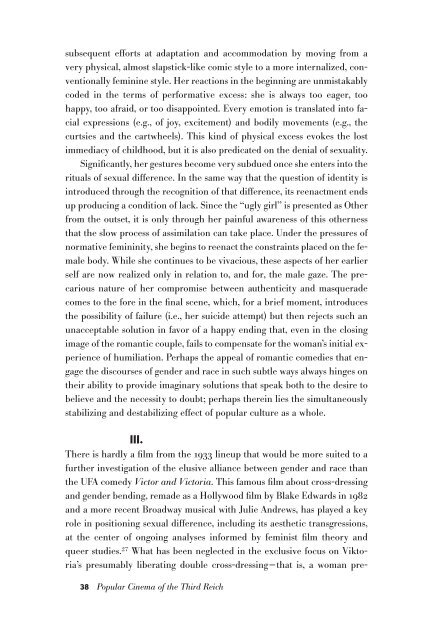You also want an ePaper? Increase the reach of your titles
YUMPU automatically turns print PDFs into web optimized ePapers that Google loves.
subsequent efforts at adaptation and accommodation by moving from a<br />
very physical, almost slapstick-like comic style to a more internalized, conventionally<br />
feminine style. Her reactions in the beginning are unmistakably<br />
coded in the terms of performative excess: she is always too eager, too<br />
happy, too afraid, or too disappointed. Every emotion is translated into facial<br />
expressions (e.g., of joy, excitement) and bodily movements (e.g., the<br />
curtsies and the cartwheels). This kind of physical excess evokes the lost<br />
immediacy of childhood, but it is also predicated on the denial of sexuality.<br />
Significantly, her gestures become very subdued once she enters into the<br />
rituals of sexual difference. In the same way that the question of identity is<br />
introduced through the recognition of that difference, its reenactment ends<br />
up producing a condition of lack. Since the “ugly girl” is presented as Other<br />
from the outset, it is only through her painful awareness of this otherness<br />
that the slow process of assimilation can take place. Under the pressures of<br />
normative femininity, she begins to reenact the constraints placed on the female<br />
body. While she continues to be vivacious, these aspects of her earlier<br />
self are now realized only in relation to, and for, the male gaze. The precarious<br />
nature of her compromise between authenticity and masquerade<br />
comes to the fore in the final scene, which, for a brief moment, introduces<br />
the possibility of failure (i.e., her suicide attempt) but then rejects such an<br />
unacceptable solution in favor of a happy ending that, even in the closing<br />
image of the romantic couple, fails to compensate for the woman’s initial experience<br />
of humiliation. Perhaps the appeal of romantic comedies that engage<br />
the discourses of gender and race in such subtle ways always hinges on<br />
their ability to provide imaginary solutions that speak both to the desire to<br />
believe and the necessity to doubt; perhaps therein lies the simultaneously<br />
stabilizing and destabilizing effect of popular culture as a whole.<br />
III.<br />
There is hardly a film from the 1933 lineup that would be more suited to a<br />
further investigation of the elusive alliance between gender and race than<br />
the UFA comedy Victor and Victoria. This famous film about cross-dressing<br />
and gender bending, remade as a Hollywood film by Blake Edwards in 1982<br />
and a more recent Broadway musical with Julie Andrews, has played a key<br />
role in positioning sexual difference, including its aesthetic transgressions,<br />
at the center of ongoing analyses informed by feminist film theory and<br />
queer studies. 27 What has been neglected in the exclusive focus on Viktoria’s<br />
presumably liberating double cross-dressing—that is, a woman pre-<br />
38 Popular Cinema of the Third Reich

















